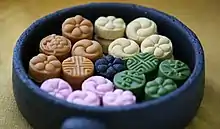Dasik
Dasik (Korean: 다식; lit. "tea food") is a bite-size hangwa that is normally accompanied by tea.[1][2] It can be made by kneading grain or other edible seed flour or pollen with honey, then pressing them into a decorative mould called dasikpan (다식판).[3] A dasik plate usually consists of an assortment of dasik of different colours, including green, yellow, pink, black, and white. Typical ingredients include: rice flour, pine pollen, black sesame, chestnut, and soybean.
 | |
| Type | Hangwa |
|---|---|
| Course | Dessert |
| Place of origin | Korea |
| Main ingredients | grain or other edible seed flour or pollen, and honey |
| Dasik | |
| Hangul | 다식 |
|---|---|
| Hanja | |
| Revised Romanization | dasik |
| McCune–Reischauer | tashik |
| IPA | [taɕik̚] |
 |
| This article is part of a series on |
| Korean cuisine 한국 요리 조선 료리 |
|---|
Varieties
- bam dasik (밤다식) – made of steamed and mashed chestnut, or chestnut powder from finely sliced and sun-dried chestnuts
- geomeunkkae dasik (검은깨다식) – made of toasted black sesame seed powder
- kkae dasik (깨다식) – made of toasted sesame seed powder
- kong dasik (콩다식) – made of steamed and pounded yellow soybean
- pureunkong dasik (푸른콩다식) – made of steamed and pounded green soybean
- songhwa dasik (송화다식) – made of pine pollen
- ssal dasik (쌀다식) – made of steamed, dried, toasted, and then pounded glutinous rice flour
Origin
The dasik was introduced to Korea some 1,600 years ago from India along with Buddhism and tea culture. Tea was first introduced to Korean royalty, and later reached the upper classes. Due to the region's climate, Korean farm land is unsuitable for the cultivation of tea, which made it difficult for the elite class to enjoy the foreign drink. Buddhist ceremonies were the most common times one would drink tea, making Bhuddist temples centers of Korean tea culture.
The tea culture flourished during the Goryeo Dynasty (918–1392) and promoted the virtues of Buddhism. During the Joseon Dynasty (1392–1910), tea culture declined as the ruling class adopted Confucian doctrine. The tea culture from Korea eventually reached Japan, which embraced other cultural influences.
Hardships of farming not only affected men, but women as well who looked after children and prepared meals after a long day of working in the fields. The government designated one day each month where culinary delicacies were prepared as a way to promote a healthy family life and to free women from some of their daily burden. These monthly celebrations included Seollal, New Year's, the first day of the first lunar month and Chuseok, Harvest Moon Festival, the fifteenth day of the eighth lunar month, when the harvest begins, making it the most abundant time of the year. During these holidays, ancestors were honored with food offerings and would pour alcoholic beverages in a ceremony called charye, a name that came from serving tea or cha to ancestors. The offerings included meat, fish, fruit, and special delicacies, often decorated elaborately. Gokcha, a type of wine and was sometimes used instead of tea. Now, wine is more included instead of traditional tea.
With families that emphasize formality, the color of the dasik is carefully chosen. The desired taste, color and texture are taken into account during the process of selecting the ingredients and the processing. Dasik arrangements are by color, served on a serving plate that reflects the artistic sense of the host and it sets the tone of the celebration.[4]
Dasikpan
Dasik is shaped with a wooden or porcelain press that forms a patterned confectionery. The press is engraved with a design that forms an embossed pattern on the dasik piece. The design would symbolize the family's name in order to wish for a long life or for a special event, like hwangap or 60th birthday or weddings.[5] Press the dough into a Dasikpan that has letters, flowers or a geometric pattern is embossed. The surface of dasik has letters, flower patterns, or Chinese letters 壽·福·康·寧 representing long life, luck, health and peacefulness. Two dasikpan forms one set. Its length is 30–60㎝, width is 5–6㎝, and thickness is 2–3㎝.
See also
References
- "다식03(茶食)" [dasik]. Standard Korean Dictionary (in Korean). National Institute of Korean Language. Retrieved 11 January 2009.
- Meyer, Chad (2 October 2008). "Uniqueness of Korean Desserts". The Korea Times. Retrieved 8 November 2014.
- Kwon, Yong-Seok; Kim, Young; Kim, Yang-Suk; Choe, Jeong-Sook; Lee, Jin-Young (2012). "An Exploratory Study on Kwa-Jung-ryu of Head Families". Journal of the Korean Society of Food Culture. 27 (6): 588–597. doi:10.7318/kjfc/2012.27.6.588.
- Koo Chun-sur (2002) Dasik: A Unique Delicacy to Accompany Tea Koreana A Quarterly on Korean Art & Culture web:http://koreana.kf.or.kr/view.asp?article_id=4606&lang=English Archived 2014-12-17 at the Wayback Machine Retrieved on 7 November 2014
- Koo Chun-sur Dasik: A Unique Delicacy to Accompany Tea Koreana A Quarterly on Korean Art & Culture web: http://koreana.kf.or.kr/view.asp?article_id=4606&lang=English Archived 2014-12-17 at the Wayback Machine Retrieved on: 7 November 2014
External links
- Dasik: Unique Delicacy to Accompany Tea
- Sweet treats for teatime snacks article at JoongAng Ilbo
- "다식 : 지식백과". Terms.naver.com. Retrieved 2013-05-12.